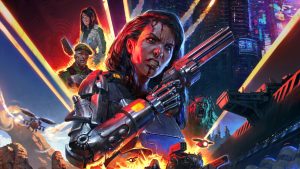
The advent of next generation consoles is upon us and lighting technology is going to play a big role in making video games feel more realistic. We got in touch with the COO of Geomerics, the company behind the lighting technology Enlighten .
Enlighten is being used in several upcoming next generation games like Battlefield 4, Dragon Age Inquisition, The Bureau – XCOM Declassified and Mirror’s Edge. We asked Chris several questions ranging from the amount of RAM in next generation consoles to whether hundreds of light sources are possible in real time.
Check out the entire interview below.

Chris Doran, founder and COO of Geomerics.
Ravi Sinha: What can you tell us about the current version of Enlighten which can be seen in upcoming games like Battlefield 4, and even games yet to be showcased like Dragon Age Inquisition? How does it improve on the previous version?
Chris Doran: Enlighten in continuously evolving to suit customer requirements and take advantage of new hardware. One of the most obvious in Battlefield 4 is the introduction of new technology for handling indirect light bouncing off ‘shiny’ surfaces.
It is quite subtle, but adds an extra layer of realism. DICE have also ramped up the degree of dynamism in Battlefield 4, particularly on next-generation hardware. There are more dynamic lights, and huge levels of destruction. Essentially everything is bigger, bolder and brighter on the new hardware, as you would hope to see with a console transition.
Click HD to see the video in its full glory.
Ravi Sinha: Speaking on light sources, the recent Unreal Engine 4 “Infiltrator” demo showcased hundreds of light sources, all presumably in real time. Is this theoretically possible during actual gameplay, when so many other factors come into play?
Chris Doran: You may have seen that we recently announced our integration into UE4 and we have a good understanding of the lighting model used in the “Infiltrator” demo. For “Infiltrator”, they used a mixture of baked and real-time lights, which is a good strategy in many cases.
However, using a modern deferred renderer, hundreds of dynamic light sources in UE4 (or Frostbite 3) are feasible, provided there are only a handful in each tile. As is often the case in game development, many of the optimisations are in the hand of the artists, who have to lay out the geometry in lights in sensible arrangements so that the renderer can cope.
Ravi Sinha: When it comes to console technology, be it next generation or current generation, what are the most important factors for creating realistic lighting? How do consoles like the PS4 and Xbox One facilitate those needs in their own ways?
Chris Doran: The simple answer is compute resource and memory. The more we have of both of these the better. Fortunately, both of the new consoles have given developers a huge increase in memory, and gone with high-end GPUs where most of the graphics compute resource sits. The consoles also have unified memory architectures, so the CPU cores and the GPU can share memory resources.
"I’m sure as the cycle evolves, developers will look at ways to squeeze more out of the PS4, but we have a long way to go with exploiting the opportunities presented by the massive jump in resource over PS3 and 360."
This is where many of the really interesting techniques are developed. But it should also be said that the tools are equally important for computing good lighting. You cannot get good lighting just by throwing algorithms at a game – you need good tools, like those offered by Enlighten, so that an artist can interact with the world they are creating and instantly see the results on the target platform. The algorithms and hardware take over once the artist has had the chance to achieve their vision.
Ravi Sinha: Let’s get the simple stuff out of the way: the Xbox One’s 8 GB DDR3 RAM, of which 5 GB is allocated for games, versus the PlayStation 4’s 8 GB GDDR5 RAM, of which 7 GB is for games. Which one presents a better solution for crafting realistic lighting?
Chris Doran: Both of these are more than sufficient. To understand why, you have to remember than on the current generation we had around 512MB of memory to play with. This meant that developers would routinely ask us to fit our global illumination calculations into 10-20MB. On the next-generation consoles, developers are happy to give us 10 times more space to play with – in some cases even more! And with 8 CPU cores and powerful GPUs, there is plenty of compute resource for us to make use of.
It is this massive increase from current generation to next generation that really excites us – that factor of 10 increase is going to be far more significant than the additional memory on the PS4. I’m sure as the cycle evolves, developers will look at ways to squeeze more out of the PS4, but we have a long way to go with exploiting the opportunities presented by the massive jump in resource over PS3 and 360.
The next generation of Battlefield will be using Enlighten.
Ravi Sinha: With every new generation of consoles, we’ve seen developers really begin to take advantage of the tech several years after their release. How long do you think it will take before developers can fully utilize the power of PS4 and Xbox One for creating realistic lighting using Enlighten?
Chris Doran: I think this cycle is a bit different, for two reasons. The first is that it has been a long time coming, and some developers have been gearing up for it for over two years. Both Sony and Microsoft went out of their way to get the key tools and middleware guys on board early as well, so that everything was ready for launch. The second reason is that both Sony and Microsoft have gone for a PC-like architecture that is well understood by developers.
A lot of the additional power is in the GPU, and most developers know how to get good results out of these devices. So I actually think a number of the launch titles will already be utilizing much of the power of the PS4 and Xbox One to deliver great graphics and lighting using Enlighten. In previous transitions it has not been unusual for the launch titles to only be marginally better than the tail end of the previous generation. In terms of graphics that will not be the case this time round. What will take longer is evolving the gameplay, the AI, and making use of the new possibilities with cloud computing and second screen gaming that the new platforms provide.
"We would like to achieve something similar (CGI graphics) in games, but we don’t have the freedom to inject an artist’s input as you move round your world. This makes better compositing more challenging in games, but I am confident we will see some major improvements on the new hardware."
Ravi Sinha: Will the PS4 and Xbox One ever be able to compete with PCs in regards to creating realistic lighting? Is there still a gulf between the capabilities of next gen consoles to do so, or is the gap between them and PCs even smaller than with the previous generation?
Chris Doran: I don’t see a big gap between PC capabilities and the capabilities of the PS4 and Xbox One. On some measures you could argue that the GPUs in the new consoles are not as powerful as the most expensive desktop GPUs, but that was also the case at the last transition. It is something of a myth that consoles at launch are usually ahead of the top-end PCs. What the consoles always are at launch is the best power per dollar ratio, but if you want more power you have always had the option of going for a really expensive PC.
What you should remember with the PS4 and Xbox One is that both have been highly tuned specifically for games. Microsoft and Sony both spent years working with developers on these specs, and it is not a coincidence that they have both chosen similar hardware designs. There are also a bunch of other technologies unique to the consoles that make them perfect for games (hardware units for specific tasks, driver extensions, etc). As with previous generations, it will be a few years before PC games start to out-strip the graphical quality seen on consoles. For the next few years PS4 and Xbox One will set the standard.
Gamers have been waiting for Avatar level graphics in video games but there are several hurdles and challenges.
Ravi Sinha: It’s been mentioned that the next generation will bring post-production processes on par with films, as multiple stacked layers and local dynamic control will be available for each pass to enhance visuals. Can you explain this process to us in greater detail?
Chris Doran: For us, this is an area of active research and it is a bit too early to start going into great detail. But the overall picture is quite simple. About 5 years ago we sat down with the lead lighting artist at Pixar and asked him to critique some screenshots from games. His first comment was that the global illumination needed improving. His second comment was that the images would be improved in film by better compositing of the frame. We’ve spent the last 5 years sorting out his first problem, and are starting to think about the second, as are a number of studios.
In a film CGI setting, many aspects of the final image would be computed separately: the direct lighting; the indirect lighting; an AO pass; volumetric effects; motion blur … Each of these would be a separate layer, and an artist would composite these together using advanced tools to achieve the final image. We would like to achieve something similar in games, but we don’t have the freedom to inject an artist’s input as you move round your world. This makes better compositing more challenging in games, but I am confident we will see some major improvements on the new hardware.
Ravi Sinha: What specific advantages does the AMD-based CPUs and GPUs of the PS4 and Xbox One present for Enlighten over the previous generation of consoles?
Chris Doran: More memory and more compute power, both on the CPU and GPU!
"Consoles will continue to service the ¼ billion core gamers out there, and mobile will continue to grow the market further "
Ravi Sinha: Siggraph is coming up. Do you plan to show any lighting for next-gen consoles there? If not, can you give us a glimpse of what your future plans hold?
Chris Doran: Actually, for this SIGGRAPH we are focusing on showing our mobile technology. We have been collaborating with ARM on new graphics techniques for mobile devices, and are presenting a lecture on this in the SIGGRAPH mobile session. We are also demonstrating this work on the show floor in the ARM booth.
In terms of the future of Enlighten, E3 was pretty telling. We have high-profile titles coming out with a number of publishers in the next 12-18 months, including Battlefield 4; Dragon Age Inquisition; The Bureau – XCOM Declassified; Star Wars Battlefront and Mirrors Edge 2. Personally I think it’s great that everyone is energised again about the next generation of consoles, and we have moved on from the tedious debate of whether mobile platforms will replace consoles.
Consoles will continue to service the ¼ billion core gamers out there, and mobile will continue to grow the market further and hopefully take high-quality games (and Enlighten) to a new generation of gamers.
A big thank you to Eric Schumacher from Neology Concepts for setting this interview up.
















Share Your Thoughts Below (Always follow our comments policy!)